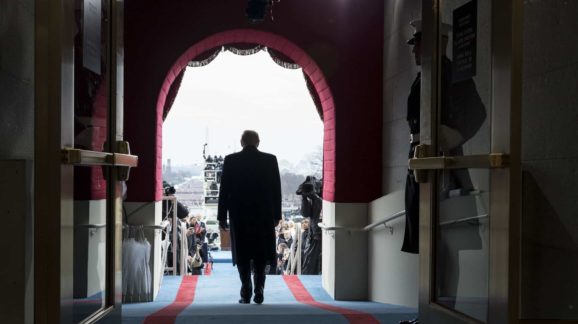Donald Trump Showcases Four Years Of Red Tape Reduction At White House Event
The White House hosted a midsummer South Lawn celebration showcasing the Trump administration’s reforms and reductions of “job killing regulations” and red tape.
The event included, along with President Trump and Vice President Mike Pence, a number of cabinet members including Transportation Secretary Elaine Chao, Commerce Secretary Wilbur Ross (unfortunately since hospitalized but apparently doing well) and Environmental Protection Agency Administrator Andrew Wheeler. Two governors and numerous state legislators were also in attendance.
For over three years, the center of gravity of the Trump deregulatory program has been Executive Order 13,771, dubbed “Reducing Regulation and Controlling Regulatory Costs.” This directive requires that, in order to issue a significant rule, agencies must eliminate at least two other rules. In the process, the aggregate net new federal regulatory costs may not be greater than zero.
Many of the administration’s cuts have been unprecedented, and its reductions in pages of regulation unparalleled, assuming they remain permanent. Trump boasted that agencies exceeded their mandate by cutting seven not merely two rules for every one added, and by cutting $50 billion in costs. A bulleted sheet of highlights was provided to media.
Trump hammered overregulation’s cost to families and promised many tens of billions in cost reductions yet to come in the wake of developments like: a new rule modernizing the National Environmental Policy Act and limiting the delays in deploying infrastructure; the repeal of the Waters of the United States rule; and the replacement of harsh prior auto fuel standards with the Safer Affordable Fuel Efficient Vehicles rule. He jokingly cheered the reemergence of incandescent light bulbs and dishwashers and washing machines that work.
Addressing Arizona rancher Jim Chilton, who spoke at the event as a victim of overreach of the Waters of the United States rule, Trump warned:
“The hard left wants to reverse these extraordinary gains, reimpose these disastrous regulations. They want to take what we’ve taken off, Jim, and they want to put them back on.”
Changes such as improved access to telemedicine spurred by 2020’s health crisis that shut down so much of the economy were also touted, with the president asserting that, “In total, we’ve taken more than 740 actions to suspend regulations that would have slowed our response.” Such measures have featured prominently this summer in the “NeverNeeded” regulations campaign of the Competitive Enterprise Institute (my own organization).
To be sure, a substantial amount of regulation has been added during the Trump administration, too. I’ve taken to calling these discordant moves (like antitrust, tech and trade interventions) “swamp things,” and see them as a genuine threat to the foundations of the reform enterprise. But the streamlining campaign under Trump has nonetheless been unique, explicitly taking on the administrative state and the progressive ideology sweeping the nation.
My favorite takeaway from Trump’s South Lawn remarks:
“Unlike the socialists, we believe in the rule of the people, not the rule of the unelected bureaucrats that don’t know what they’re doing. We believe in the dignity of the individual, not the iron grip of the state. Our regulatory reforms are vital, not only to the success of our economy, but the strength of our democracy, and the survival of liberty itself.”
In wrapping up, and before introducing Vice President Pence, Trump assured the crowd:
“My Administration will continue pressing forward until we have made every last vestige of Washington fully, completely, and totally accountable to the citizens of the United States.”
That would be quite the achievement. Back in 1996, when I wrote the first edition of my Ten Thousand Commandments survey of the regulatory state for CEI (in which then and now I urge that Congress rather than unelected agencies answer to the people for the burdens and costs of regulation), a Washington Post story on the report was headlined, “A Think Tank Tenet: Thou Shalt Hold Congress Accountable.” Trump’s promise comes nearly a quarter century later. But better late than never!
With respect to the regulatory reductions promised in the near future, the president seemed particularly annoyed with a Department of Housing and Urban Development rule called “Affirmatively Furthering Fair Housing” or AFFH.
In today’s prolonged economic and employment crisis, deregulatory stimulus is needed instead of the flash policy (spending and more spending) to which policy makers always default in times of emergency.
President Barack Obama touted his “pen and phone” to expand government. An alternative I suggest is that Trump can use an “eraser” in 2020 to reduce it; aggressively so, but within the rule of law.
In order to continue the celebratory vibe and sustain regulatory liberalization, Trump will without doubt have to take a number additional steps unilaterally to achieve further deregulatory stimulus.
Democrats are all in with progressive expansion of government, so the Congress cannot be expected to assist in deregulatory stimulus even though there are stellar legislative options like a regulatory reduction commission and the Guidance Out of Darkness Act (or, “GOOD Act”) to require full disclosure of sub-regulatory guidance documents. In regard to the latter, Trump has, again uniquely, required something similar by executive order).
So what next on what Trump calls “Job…. Killing…. Regulations”? No telling. Many will be watching in hopes for something even more aggressive than as one-in, two-out.
(Note: a version of this column appeared on CEI.org.)
